Network Infrastructure Design for Cookie Co. - Report
VerifiedAdded on 2020/05/11
|10
|2334
|80
Report
AI Summary
This report details a proposed network infrastructure for the Cookie Co. organization, addressing issues of slow data connectivity and unreliable voice calls. The solution involves implementing network convergence and unified communications to provide reliable communication between employees and customers. The report discusses LAN types, cabling plans, WAN connections, transmission media, IP and DNS management, and various network services like VOIP, WWW, and email. Data processing facilities, including data storage locations and a distributed data processing model, are also explored. The proposed infrastructure aims to enhance communication, improve customer satisfaction, and support future company growth. The report emphasizes the benefits of unified communication, the importance of network security, and the advantages of cloud-based data storage.
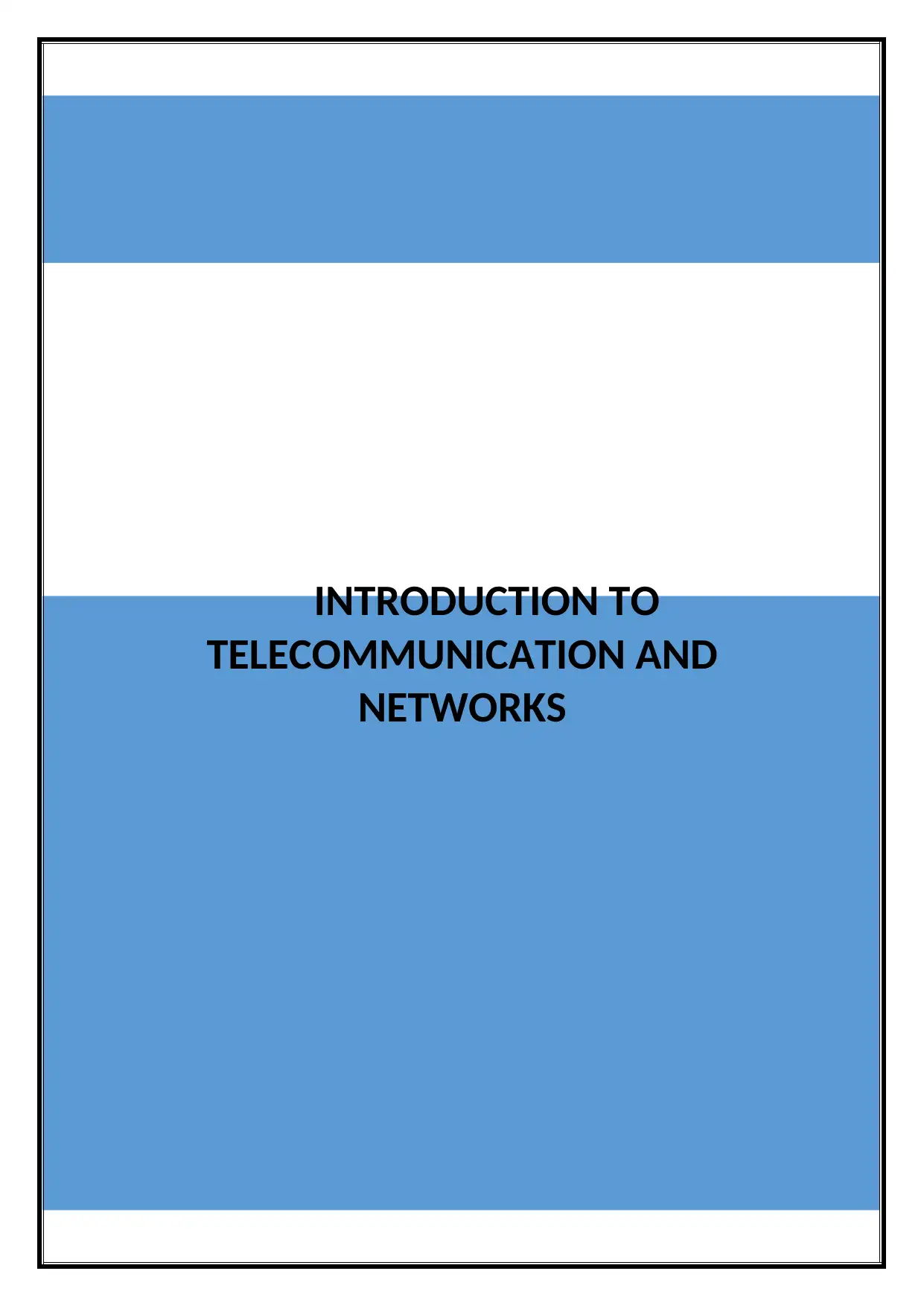
INTRODUCTION TO
TELECOMMUNICATION AND
NETWORKS
TELECOMMUNICATION AND
NETWORKS
Paraphrase This Document
Need a fresh take? Get an instant paraphrase of this document with our AI Paraphraser
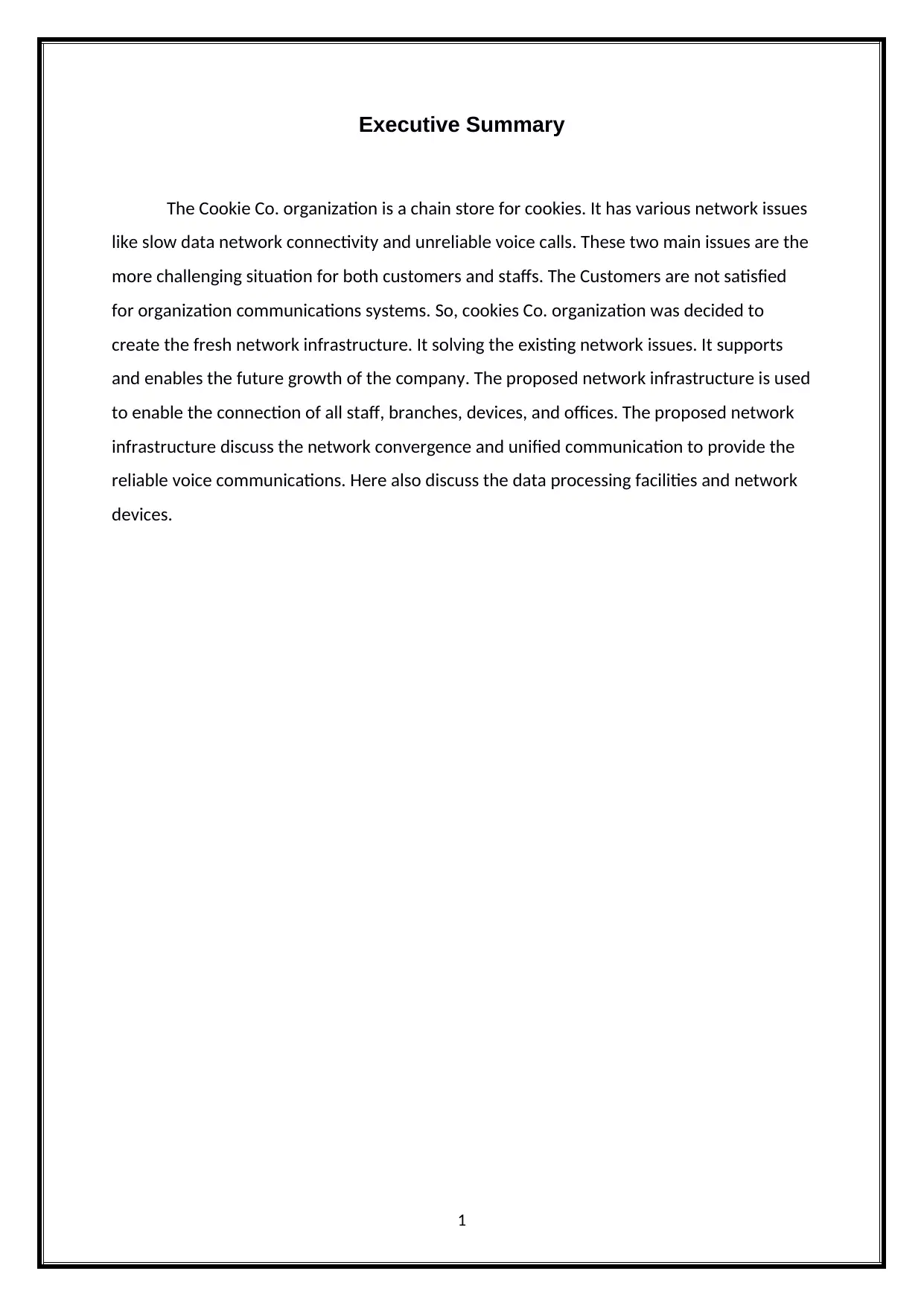
Executive Summary
The Cookie Co. organization is a chain store for cookies. It has various network issues
like slow data network connectivity and unreliable voice calls. These two main issues are the
more challenging situation for both customers and staffs. The Customers are not satisfied
for organization communications systems. So, cookies Co. organization was decided to
create the fresh network infrastructure. It solving the existing network issues. It supports
and enables the future growth of the company. The proposed network infrastructure is used
to enable the connection of all staff, branches, devices, and offices. The proposed network
infrastructure discuss the network convergence and unified communication to provide the
reliable voice communications. Here also discuss the data processing facilities and network
devices.
1
The Cookie Co. organization is a chain store for cookies. It has various network issues
like slow data network connectivity and unreliable voice calls. These two main issues are the
more challenging situation for both customers and staffs. The Customers are not satisfied
for organization communications systems. So, cookies Co. organization was decided to
create the fresh network infrastructure. It solving the existing network issues. It supports
and enables the future growth of the company. The proposed network infrastructure is used
to enable the connection of all staff, branches, devices, and offices. The proposed network
infrastructure discuss the network convergence and unified communication to provide the
reliable voice communications. Here also discuss the data processing facilities and network
devices.
1
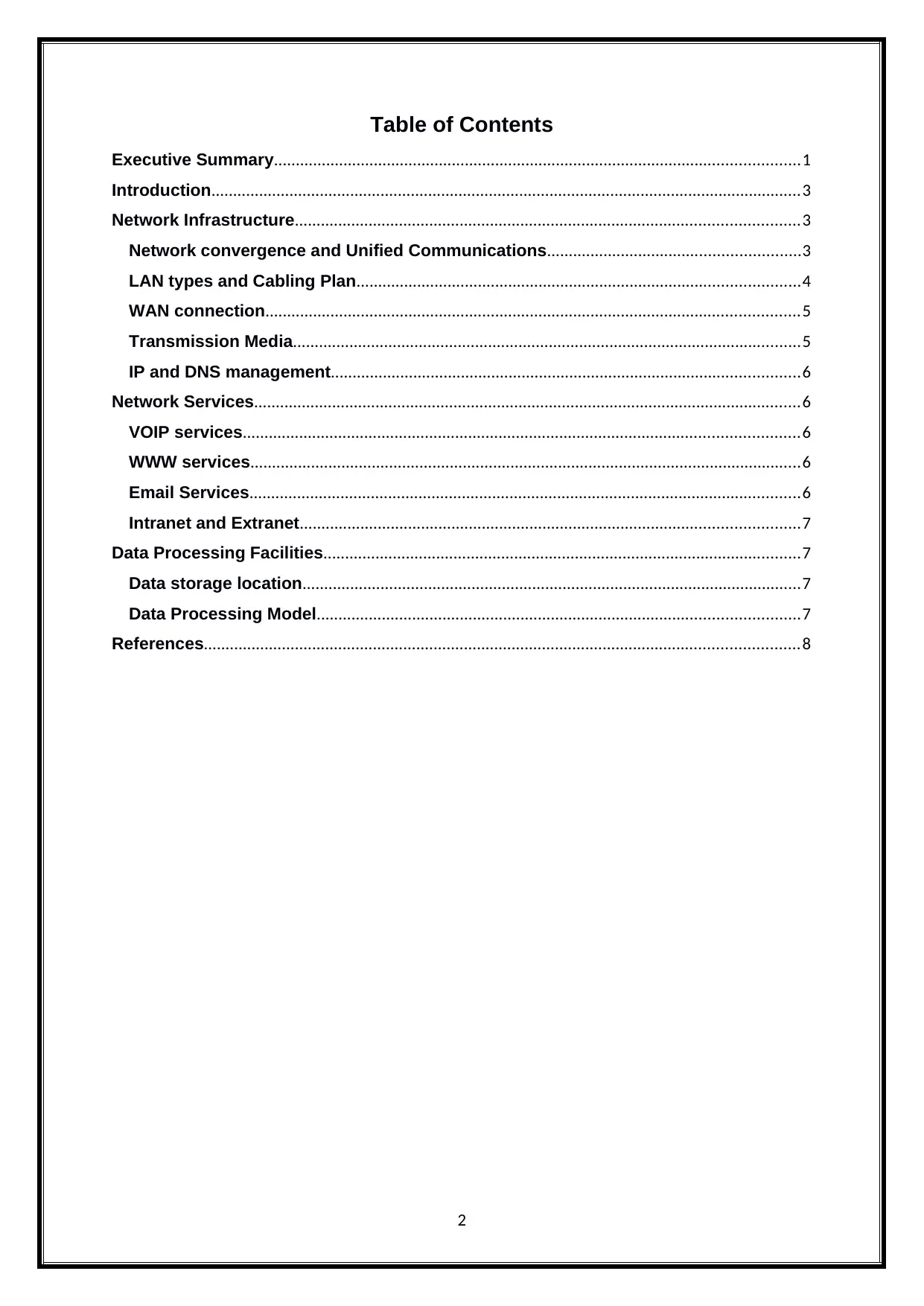
Table of Contents
Executive Summary.........................................................................................................................1
Introduction........................................................................................................................................3
Network Infrastructure....................................................................................................................3
Network convergence and Unified Communications..........................................................3
LAN types and Cabling Plan......................................................................................................4
WAN connection...........................................................................................................................5
Transmission Media.....................................................................................................................5
IP and DNS management............................................................................................................6
Network Services..............................................................................................................................6
VOIP services................................................................................................................................6
WWW services...............................................................................................................................6
Email Services...............................................................................................................................6
Intranet and Extranet...................................................................................................................7
Data Processing Facilities..............................................................................................................7
Data storage location...................................................................................................................7
Data Processing Model...............................................................................................................7
References.........................................................................................................................................8
2
Executive Summary.........................................................................................................................1
Introduction........................................................................................................................................3
Network Infrastructure....................................................................................................................3
Network convergence and Unified Communications..........................................................3
LAN types and Cabling Plan......................................................................................................4
WAN connection...........................................................................................................................5
Transmission Media.....................................................................................................................5
IP and DNS management............................................................................................................6
Network Services..............................................................................................................................6
VOIP services................................................................................................................................6
WWW services...............................................................................................................................6
Email Services...............................................................................................................................6
Intranet and Extranet...................................................................................................................7
Data Processing Facilities..............................................................................................................7
Data storage location...................................................................................................................7
Data Processing Model...............................................................................................................7
References.........................................................................................................................................8
2
⊘ This is a preview!⊘
Do you want full access?
Subscribe today to unlock all pages.

Trusted by 1+ million students worldwide
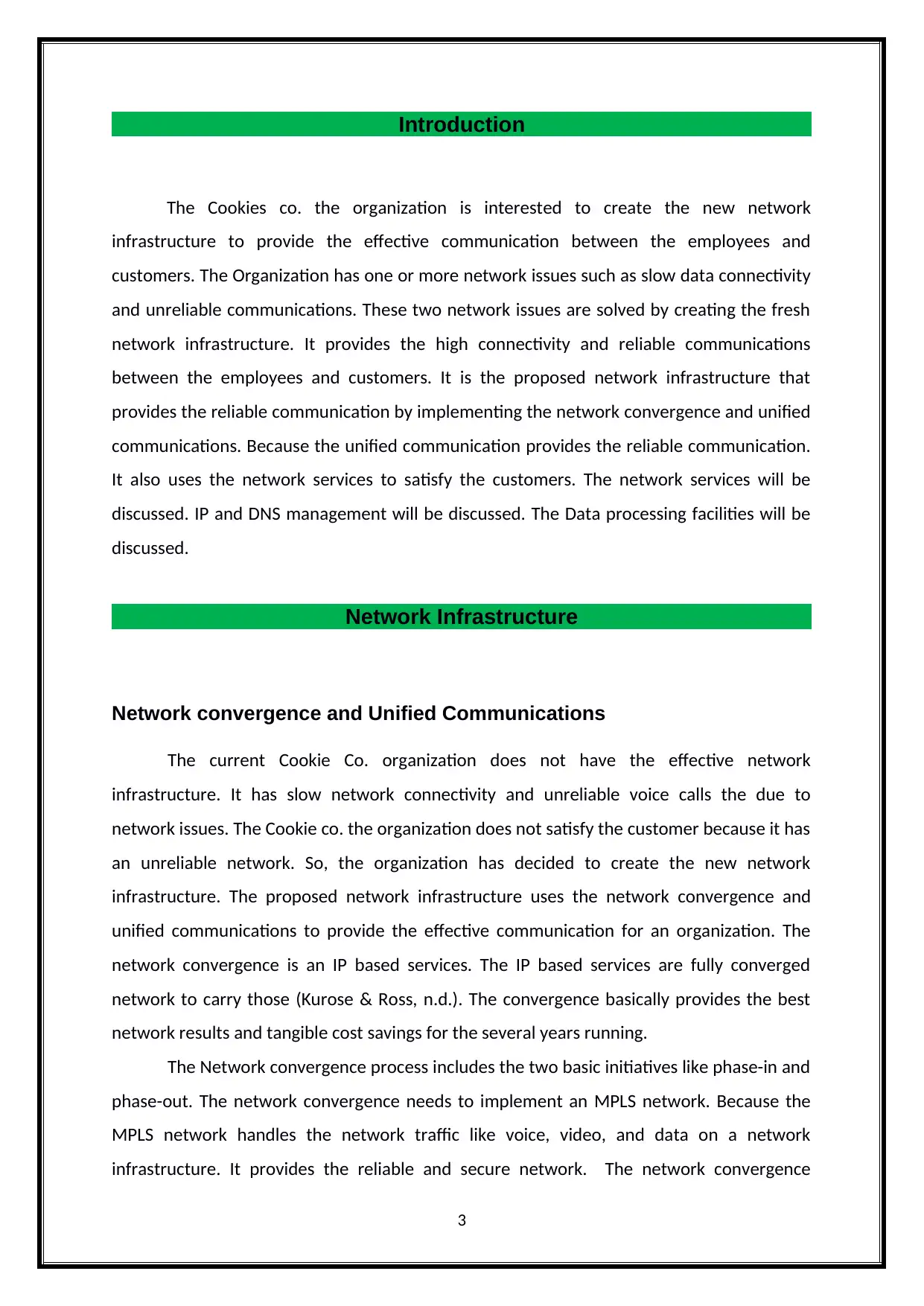
Introduction
The Cookies co. the organization is interested to create the new network
infrastructure to provide the effective communication between the employees and
customers. The Organization has one or more network issues such as slow data connectivity
and unreliable communications. These two network issues are solved by creating the fresh
network infrastructure. It provides the high connectivity and reliable communications
between the employees and customers. It is the proposed network infrastructure that
provides the reliable communication by implementing the network convergence and unified
communications. Because the unified communication provides the reliable communication.
It also uses the network services to satisfy the customers. The network services will be
discussed. IP and DNS management will be discussed. The Data processing facilities will be
discussed.
Network Infrastructure
Network convergence and Unified Communications
The current Cookie Co. organization does not have the effective network
infrastructure. It has slow network connectivity and unreliable voice calls the due to
network issues. The Cookie co. the organization does not satisfy the customer because it has
an unreliable network. So, the organization has decided to create the new network
infrastructure. The proposed network infrastructure uses the network convergence and
unified communications to provide the effective communication for an organization. The
network convergence is an IP based services. The IP based services are fully converged
network to carry those (Kurose & Ross, n.d.). The convergence basically provides the best
network results and tangible cost savings for the several years running.
The Network convergence process includes the two basic initiatives like phase-in and
phase-out. The network convergence needs to implement an MPLS network. Because the
MPLS network handles the network traffic like voice, video, and data on a network
infrastructure. It provides the reliable and secure network. The network convergence
3
The Cookies co. the organization is interested to create the new network
infrastructure to provide the effective communication between the employees and
customers. The Organization has one or more network issues such as slow data connectivity
and unreliable communications. These two network issues are solved by creating the fresh
network infrastructure. It provides the high connectivity and reliable communications
between the employees and customers. It is the proposed network infrastructure that
provides the reliable communication by implementing the network convergence and unified
communications. Because the unified communication provides the reliable communication.
It also uses the network services to satisfy the customers. The network services will be
discussed. IP and DNS management will be discussed. The Data processing facilities will be
discussed.
Network Infrastructure
Network convergence and Unified Communications
The current Cookie Co. organization does not have the effective network
infrastructure. It has slow network connectivity and unreliable voice calls the due to
network issues. The Cookie co. the organization does not satisfy the customer because it has
an unreliable network. So, the organization has decided to create the new network
infrastructure. The proposed network infrastructure uses the network convergence and
unified communications to provide the effective communication for an organization. The
network convergence is an IP based services. The IP based services are fully converged
network to carry those (Kurose & Ross, n.d.). The convergence basically provides the best
network results and tangible cost savings for the several years running.
The Network convergence process includes the two basic initiatives like phase-in and
phase-out. The network convergence needs to implement an MPLS network. Because the
MPLS network handles the network traffic like voice, video, and data on a network
infrastructure. It provides the reliable and secure network. The network convergence
3
Paraphrase This Document
Need a fresh take? Get an instant paraphrase of this document with our AI Paraphraser
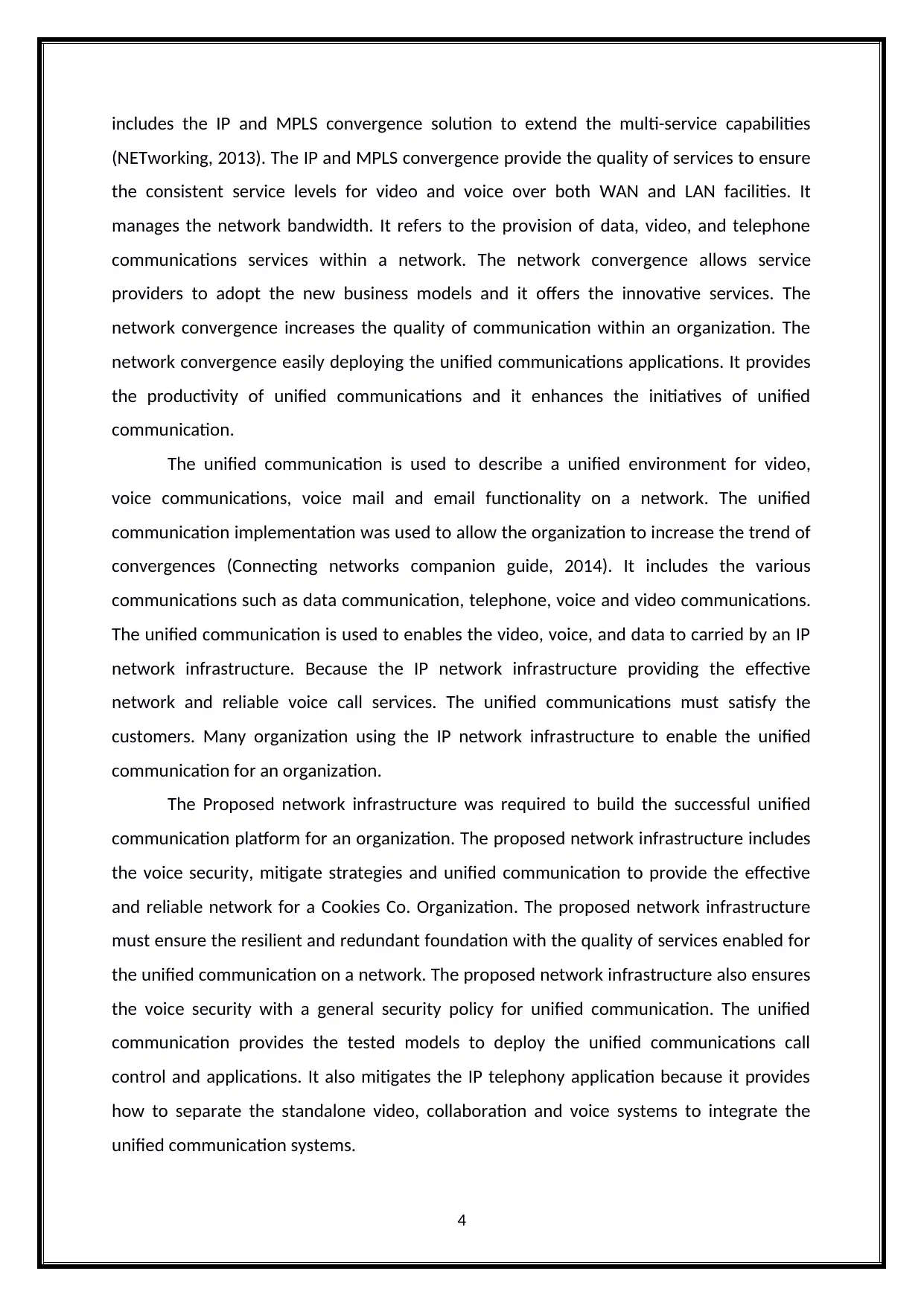
includes the IP and MPLS convergence solution to extend the multi-service capabilities
(NETworking, 2013). The IP and MPLS convergence provide the quality of services to ensure
the consistent service levels for video and voice over both WAN and LAN facilities. It
manages the network bandwidth. It refers to the provision of data, video, and telephone
communications services within a network. The network convergence allows service
providers to adopt the new business models and it offers the innovative services. The
network convergence increases the quality of communication within an organization. The
network convergence easily deploying the unified communications applications. It provides
the productivity of unified communications and it enhances the initiatives of unified
communication.
The unified communication is used to describe a unified environment for video,
voice communications, voice mail and email functionality on a network. The unified
communication implementation was used to allow the organization to increase the trend of
convergences (Connecting networks companion guide, 2014). It includes the various
communications such as data communication, telephone, voice and video communications.
The unified communication is used to enables the video, voice, and data to carried by an IP
network infrastructure. Because the IP network infrastructure providing the effective
network and reliable voice call services. The unified communications must satisfy the
customers. Many organization using the IP network infrastructure to enable the unified
communication for an organization.
The Proposed network infrastructure was required to build the successful unified
communication platform for an organization. The proposed network infrastructure includes
the voice security, mitigate strategies and unified communication to provide the effective
and reliable network for a Cookies Co. Organization. The proposed network infrastructure
must ensure the resilient and redundant foundation with the quality of services enabled for
the unified communication on a network. The proposed network infrastructure also ensures
the voice security with a general security policy for unified communication. The unified
communication provides the tested models to deploy the unified communications call
control and applications. It also mitigates the IP telephony application because it provides
how to separate the standalone video, collaboration and voice systems to integrate the
unified communication systems.
4
(NETworking, 2013). The IP and MPLS convergence provide the quality of services to ensure
the consistent service levels for video and voice over both WAN and LAN facilities. It
manages the network bandwidth. It refers to the provision of data, video, and telephone
communications services within a network. The network convergence allows service
providers to adopt the new business models and it offers the innovative services. The
network convergence increases the quality of communication within an organization. The
network convergence easily deploying the unified communications applications. It provides
the productivity of unified communications and it enhances the initiatives of unified
communication.
The unified communication is used to describe a unified environment for video,
voice communications, voice mail and email functionality on a network. The unified
communication implementation was used to allow the organization to increase the trend of
convergences (Connecting networks companion guide, 2014). It includes the various
communications such as data communication, telephone, voice and video communications.
The unified communication is used to enables the video, voice, and data to carried by an IP
network infrastructure. Because the IP network infrastructure providing the effective
network and reliable voice call services. The unified communications must satisfy the
customers. Many organization using the IP network infrastructure to enable the unified
communication for an organization.
The Proposed network infrastructure was required to build the successful unified
communication platform for an organization. The proposed network infrastructure includes
the voice security, mitigate strategies and unified communication to provide the effective
and reliable network for a Cookies Co. Organization. The proposed network infrastructure
must ensure the resilient and redundant foundation with the quality of services enabled for
the unified communication on a network. The proposed network infrastructure also ensures
the voice security with a general security policy for unified communication. The unified
communication provides the tested models to deploy the unified communications call
control and applications. It also mitigates the IP telephony application because it provides
how to separate the standalone video, collaboration and voice systems to integrate the
unified communication systems.
4
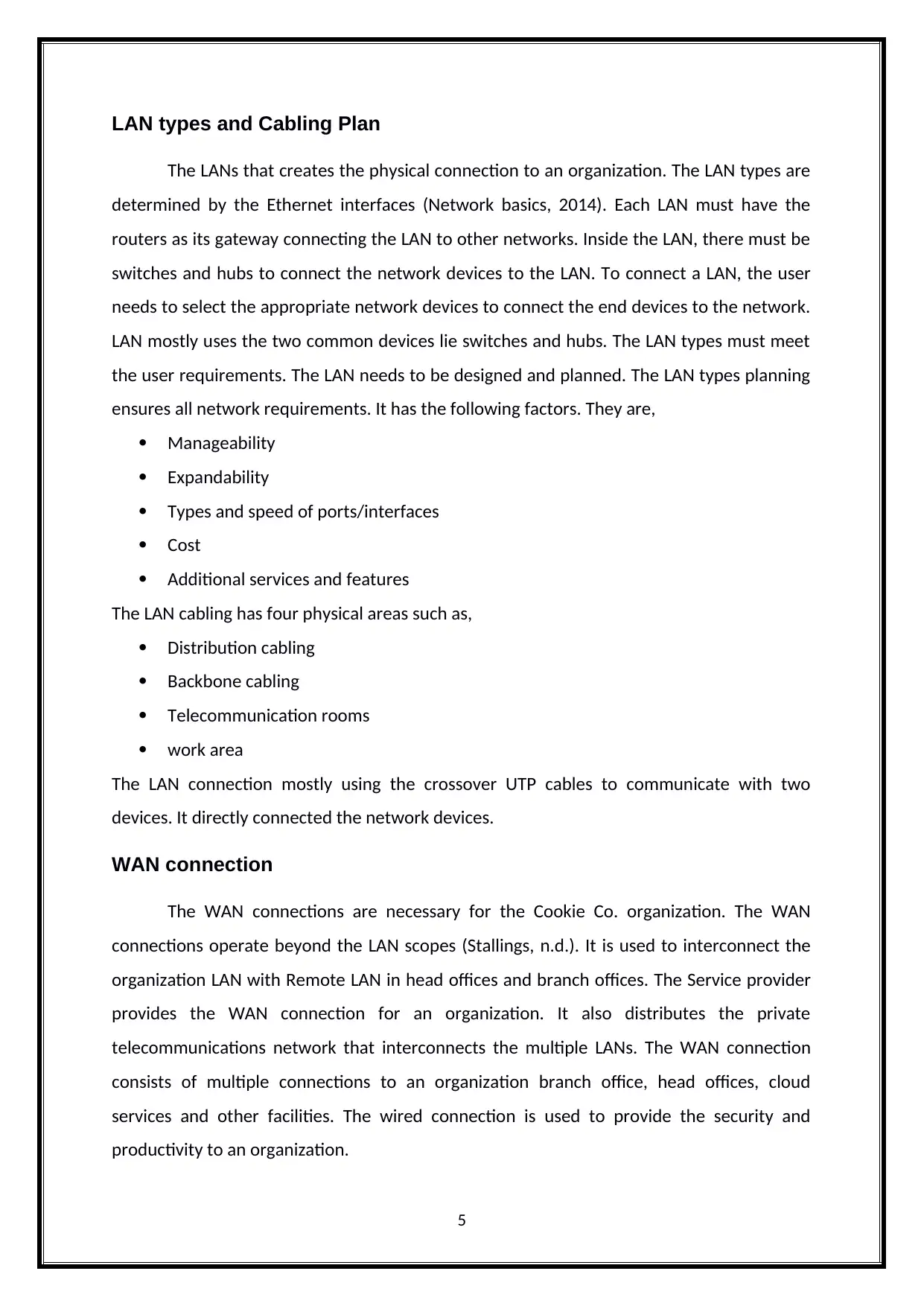
LAN types and Cabling Plan
The LANs that creates the physical connection to an organization. The LAN types are
determined by the Ethernet interfaces (Network basics, 2014). Each LAN must have the
routers as its gateway connecting the LAN to other networks. Inside the LAN, there must be
switches and hubs to connect the network devices to the LAN. To connect a LAN, the user
needs to select the appropriate network devices to connect the end devices to the network.
LAN mostly uses the two common devices lie switches and hubs. The LAN types must meet
the user requirements. The LAN needs to be designed and planned. The LAN types planning
ensures all network requirements. It has the following factors. They are,
Manageability
Expandability
Types and speed of ports/interfaces
Cost
Additional services and features
The LAN cabling has four physical areas such as,
Distribution cabling
Backbone cabling
Telecommunication rooms
work area
The LAN connection mostly using the crossover UTP cables to communicate with two
devices. It directly connected the network devices.
WAN connection
The WAN connections are necessary for the Cookie Co. organization. The WAN
connections operate beyond the LAN scopes (Stallings, n.d.). It is used to interconnect the
organization LAN with Remote LAN in head offices and branch offices. The Service provider
provides the WAN connection for an organization. It also distributes the private
telecommunications network that interconnects the multiple LANs. The WAN connection
consists of multiple connections to an organization branch office, head offices, cloud
services and other facilities. The wired connection is used to provide the security and
productivity to an organization.
5
The LANs that creates the physical connection to an organization. The LAN types are
determined by the Ethernet interfaces (Network basics, 2014). Each LAN must have the
routers as its gateway connecting the LAN to other networks. Inside the LAN, there must be
switches and hubs to connect the network devices to the LAN. To connect a LAN, the user
needs to select the appropriate network devices to connect the end devices to the network.
LAN mostly uses the two common devices lie switches and hubs. The LAN types must meet
the user requirements. The LAN needs to be designed and planned. The LAN types planning
ensures all network requirements. It has the following factors. They are,
Manageability
Expandability
Types and speed of ports/interfaces
Cost
Additional services and features
The LAN cabling has four physical areas such as,
Distribution cabling
Backbone cabling
Telecommunication rooms
work area
The LAN connection mostly using the crossover UTP cables to communicate with two
devices. It directly connected the network devices.
WAN connection
The WAN connections are necessary for the Cookie Co. organization. The WAN
connections operate beyond the LAN scopes (Stallings, n.d.). It is used to interconnect the
organization LAN with Remote LAN in head offices and branch offices. The Service provider
provides the WAN connection for an organization. It also distributes the private
telecommunications network that interconnects the multiple LANs. The WAN connection
consists of multiple connections to an organization branch office, head offices, cloud
services and other facilities. The wired connection is used to provide the security and
productivity to an organization.
5
⊘ This is a preview!⊘
Do you want full access?
Subscribe today to unlock all pages.

Trusted by 1+ million students worldwide
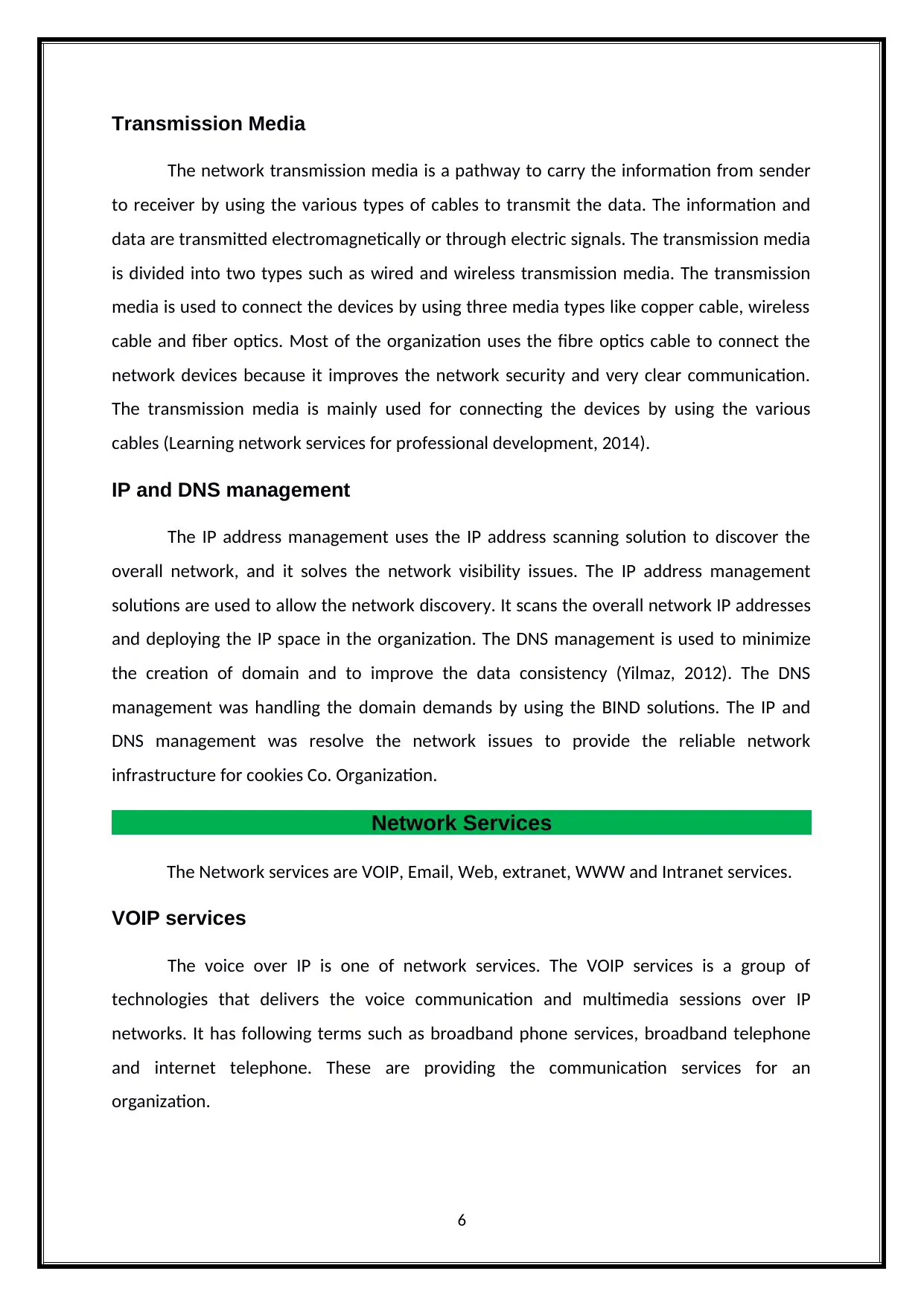
Transmission Media
The network transmission media is a pathway to carry the information from sender
to receiver by using the various types of cables to transmit the data. The information and
data are transmitted electromagnetically or through electric signals. The transmission media
is divided into two types such as wired and wireless transmission media. The transmission
media is used to connect the devices by using three media types like copper cable, wireless
cable and fiber optics. Most of the organization uses the fibre optics cable to connect the
network devices because it improves the network security and very clear communication.
The transmission media is mainly used for connecting the devices by using the various
cables (Learning network services for professional development, 2014).
IP and DNS management
The IP address management uses the IP address scanning solution to discover the
overall network, and it solves the network visibility issues. The IP address management
solutions are used to allow the network discovery. It scans the overall network IP addresses
and deploying the IP space in the organization. The DNS management is used to minimize
the creation of domain and to improve the data consistency (Yilmaz, 2012). The DNS
management was handling the domain demands by using the BIND solutions. The IP and
DNS management was resolve the network issues to provide the reliable network
infrastructure for cookies Co. Organization.
Network Services
The Network services are VOIP, Email, Web, extranet, WWW and Intranet services.
VOIP services
The voice over IP is one of network services. The VOIP services is a group of
technologies that delivers the voice communication and multimedia sessions over IP
networks. It has following terms such as broadband phone services, broadband telephone
and internet telephone. These are providing the communication services for an
organization.
6
The network transmission media is a pathway to carry the information from sender
to receiver by using the various types of cables to transmit the data. The information and
data are transmitted electromagnetically or through electric signals. The transmission media
is divided into two types such as wired and wireless transmission media. The transmission
media is used to connect the devices by using three media types like copper cable, wireless
cable and fiber optics. Most of the organization uses the fibre optics cable to connect the
network devices because it improves the network security and very clear communication.
The transmission media is mainly used for connecting the devices by using the various
cables (Learning network services for professional development, 2014).
IP and DNS management
The IP address management uses the IP address scanning solution to discover the
overall network, and it solves the network visibility issues. The IP address management
solutions are used to allow the network discovery. It scans the overall network IP addresses
and deploying the IP space in the organization. The DNS management is used to minimize
the creation of domain and to improve the data consistency (Yilmaz, 2012). The DNS
management was handling the domain demands by using the BIND solutions. The IP and
DNS management was resolve the network issues to provide the reliable network
infrastructure for cookies Co. Organization.
Network Services
The Network services are VOIP, Email, Web, extranet, WWW and Intranet services.
VOIP services
The voice over IP is one of network services. The VOIP services is a group of
technologies that delivers the voice communication and multimedia sessions over IP
networks. It has following terms such as broadband phone services, broadband telephone
and internet telephone. These are providing the communication services for an
organization.
6
Paraphrase This Document
Need a fresh take? Get an instant paraphrase of this document with our AI Paraphraser
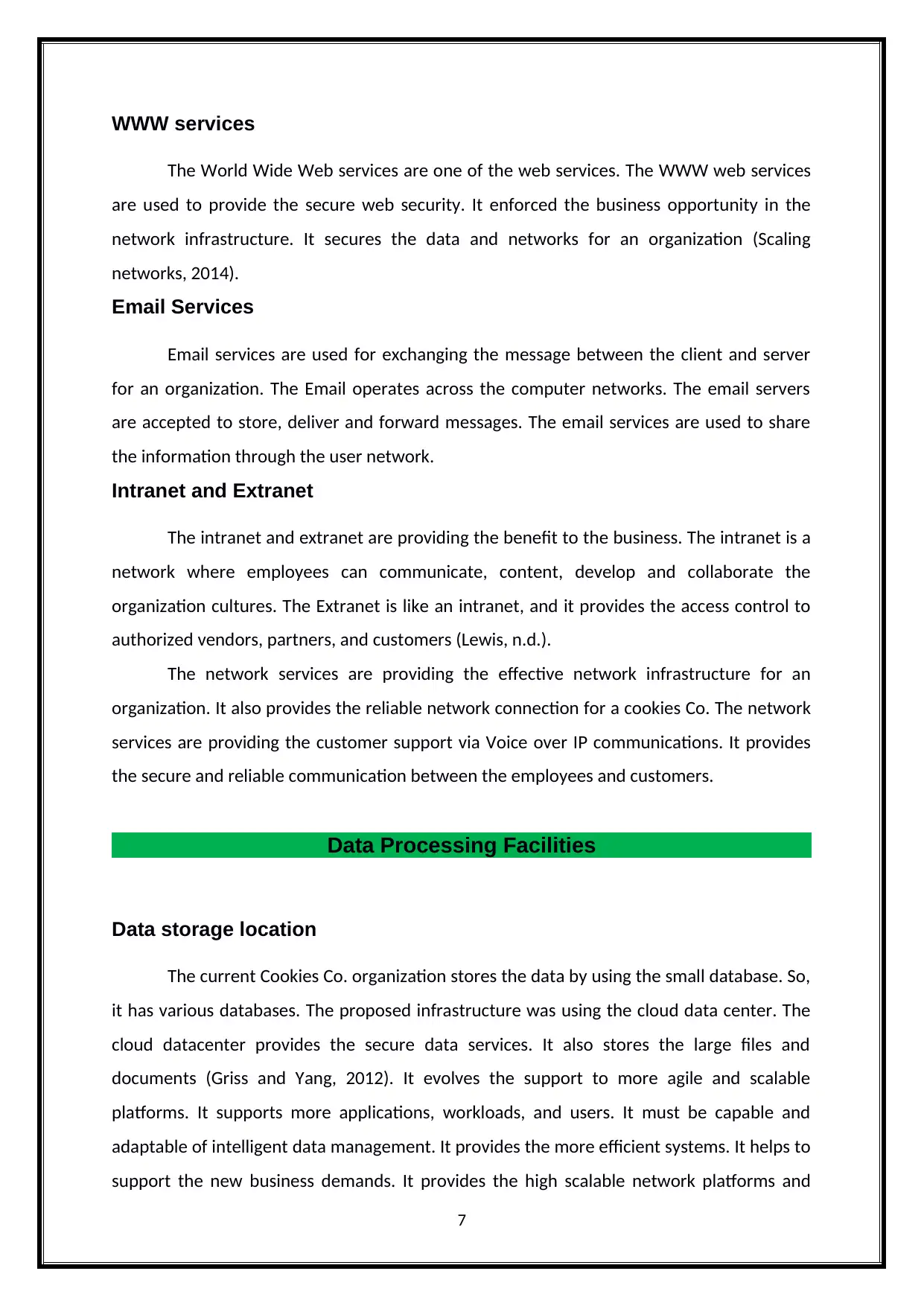
WWW services
The World Wide Web services are one of the web services. The WWW web services
are used to provide the secure web security. It enforced the business opportunity in the
network infrastructure. It secures the data and networks for an organization (Scaling
networks, 2014).
Email Services
Email services are used for exchanging the message between the client and server
for an organization. The Email operates across the computer networks. The email servers
are accepted to store, deliver and forward messages. The email services are used to share
the information through the user network.
Intranet and Extranet
The intranet and extranet are providing the benefit to the business. The intranet is a
network where employees can communicate, content, develop and collaborate the
organization cultures. The Extranet is like an intranet, and it provides the access control to
authorized vendors, partners, and customers (Lewis, n.d.).
The network services are providing the effective network infrastructure for an
organization. It also provides the reliable network connection for a cookies Co. The network
services are providing the customer support via Voice over IP communications. It provides
the secure and reliable communication between the employees and customers.
Data Processing Facilities
Data storage location
The current Cookies Co. organization stores the data by using the small database. So,
it has various databases. The proposed infrastructure was using the cloud data center. The
cloud datacenter provides the secure data services. It also stores the large files and
documents (Griss and Yang, 2012). It evolves the support to more agile and scalable
platforms. It supports more applications, workloads, and users. It must be capable and
adaptable of intelligent data management. It provides the more efficient systems. It helps to
support the new business demands. It provides the high scalable network platforms and
7
The World Wide Web services are one of the web services. The WWW web services
are used to provide the secure web security. It enforced the business opportunity in the
network infrastructure. It secures the data and networks for an organization (Scaling
networks, 2014).
Email Services
Email services are used for exchanging the message between the client and server
for an organization. The Email operates across the computer networks. The email servers
are accepted to store, deliver and forward messages. The email services are used to share
the information through the user network.
Intranet and Extranet
The intranet and extranet are providing the benefit to the business. The intranet is a
network where employees can communicate, content, develop and collaborate the
organization cultures. The Extranet is like an intranet, and it provides the access control to
authorized vendors, partners, and customers (Lewis, n.d.).
The network services are providing the effective network infrastructure for an
organization. It also provides the reliable network connection for a cookies Co. The network
services are providing the customer support via Voice over IP communications. It provides
the secure and reliable communication between the employees and customers.
Data Processing Facilities
Data storage location
The current Cookies Co. organization stores the data by using the small database. So,
it has various databases. The proposed infrastructure was using the cloud data center. The
cloud datacenter provides the secure data services. It also stores the large files and
documents (Griss and Yang, 2012). It evolves the support to more agile and scalable
platforms. It supports more applications, workloads, and users. It must be capable and
adaptable of intelligent data management. It provides the more efficient systems. It helps to
support the new business demands. It provides the high scalable network platforms and
7
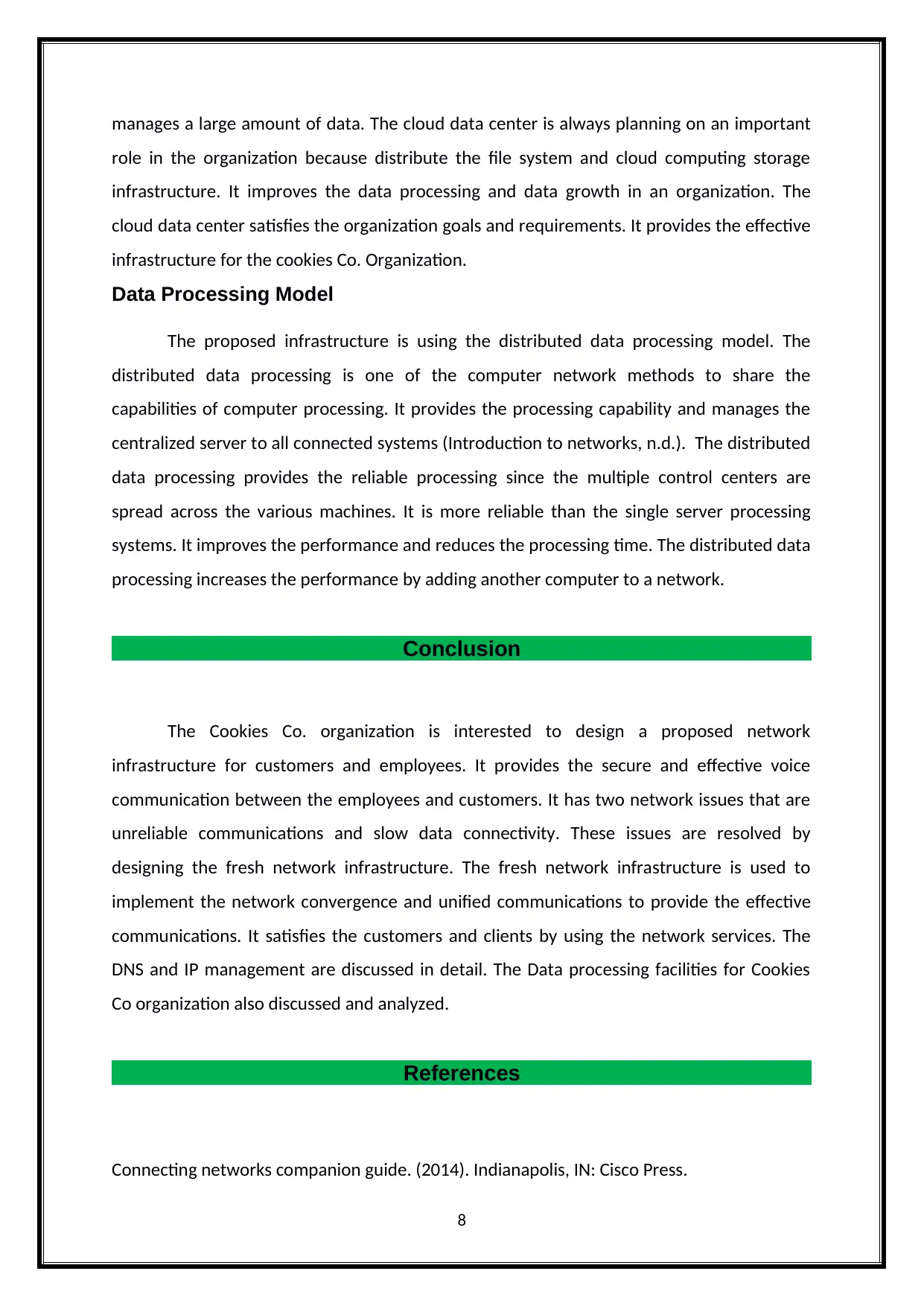
manages a large amount of data. The cloud data center is always planning on an important
role in the organization because distribute the file system and cloud computing storage
infrastructure. It improves the data processing and data growth in an organization. The
cloud data center satisfies the organization goals and requirements. It provides the effective
infrastructure for the cookies Co. Organization.
Data Processing Model
The proposed infrastructure is using the distributed data processing model. The
distributed data processing is one of the computer network methods to share the
capabilities of computer processing. It provides the processing capability and manages the
centralized server to all connected systems (Introduction to networks, n.d.). The distributed
data processing provides the reliable processing since the multiple control centers are
spread across the various machines. It is more reliable than the single server processing
systems. It improves the performance and reduces the processing time. The distributed data
processing increases the performance by adding another computer to a network.
Conclusion
The Cookies Co. organization is interested to design a proposed network
infrastructure for customers and employees. It provides the secure and effective voice
communication between the employees and customers. It has two network issues that are
unreliable communications and slow data connectivity. These issues are resolved by
designing the fresh network infrastructure. The fresh network infrastructure is used to
implement the network convergence and unified communications to provide the effective
communications. It satisfies the customers and clients by using the network services. The
DNS and IP management are discussed in detail. The Data processing facilities for Cookies
Co organization also discussed and analyzed.
References
Connecting networks companion guide. (2014). Indianapolis, IN: Cisco Press.
8
role in the organization because distribute the file system and cloud computing storage
infrastructure. It improves the data processing and data growth in an organization. The
cloud data center satisfies the organization goals and requirements. It provides the effective
infrastructure for the cookies Co. Organization.
Data Processing Model
The proposed infrastructure is using the distributed data processing model. The
distributed data processing is one of the computer network methods to share the
capabilities of computer processing. It provides the processing capability and manages the
centralized server to all connected systems (Introduction to networks, n.d.). The distributed
data processing provides the reliable processing since the multiple control centers are
spread across the various machines. It is more reliable than the single server processing
systems. It improves the performance and reduces the processing time. The distributed data
processing increases the performance by adding another computer to a network.
Conclusion
The Cookies Co. organization is interested to design a proposed network
infrastructure for customers and employees. It provides the secure and effective voice
communication between the employees and customers. It has two network issues that are
unreliable communications and slow data connectivity. These issues are resolved by
designing the fresh network infrastructure. The fresh network infrastructure is used to
implement the network convergence and unified communications to provide the effective
communications. It satisfies the customers and clients by using the network services. The
DNS and IP management are discussed in detail. The Data processing facilities for Cookies
Co organization also discussed and analyzed.
References
Connecting networks companion guide. (2014). Indianapolis, IN: Cisco Press.
8
⊘ This is a preview!⊘
Do you want full access?
Subscribe today to unlock all pages.

Trusted by 1+ million students worldwide
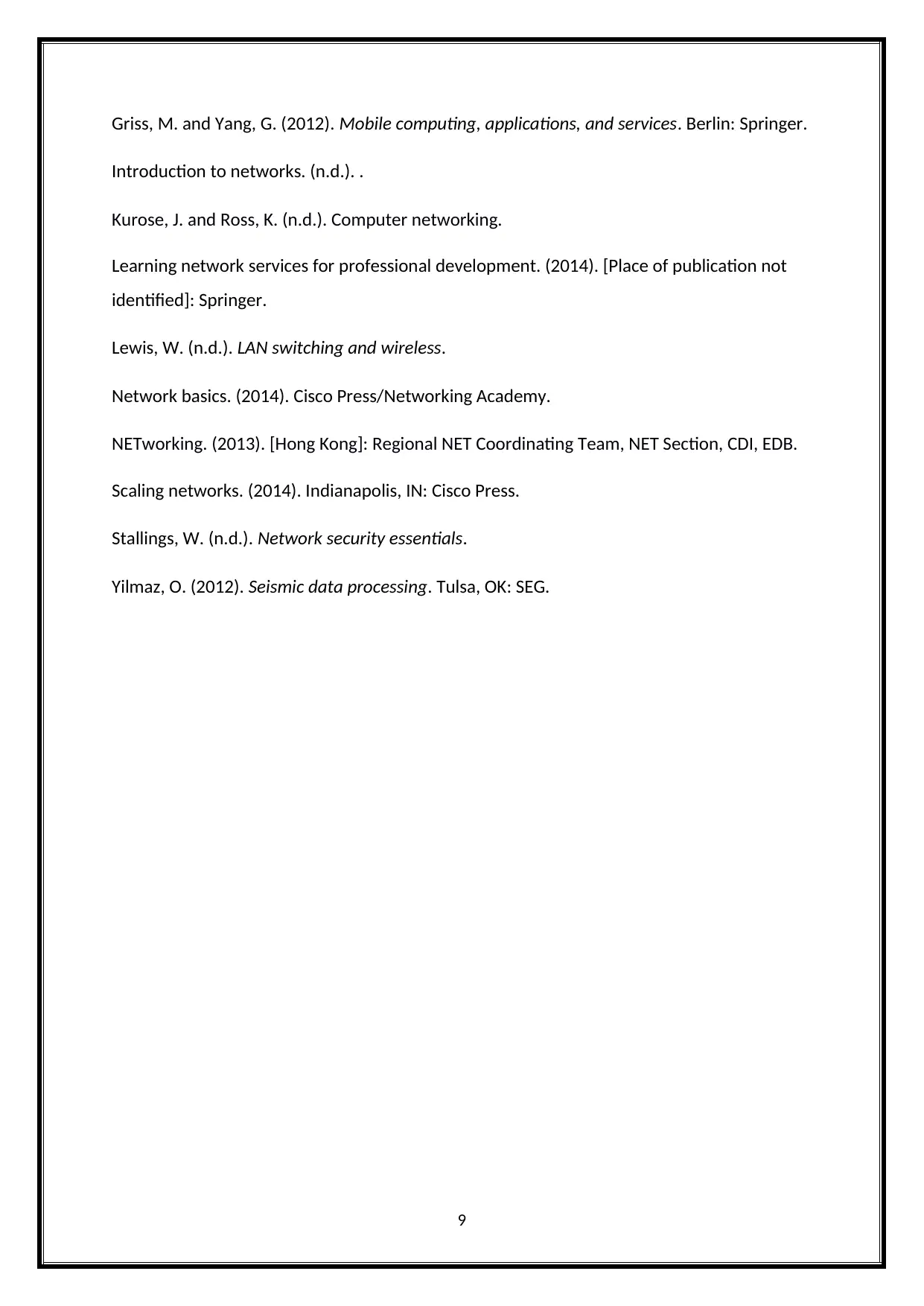
Griss, M. and Yang, G. (2012). Mobile computing, applications, and services. Berlin: Springer.
Introduction to networks. (n.d.). .
Kurose, J. and Ross, K. (n.d.). Computer networking.
Learning network services for professional development. (2014). [Place of publication not
identified]: Springer.
Lewis, W. (n.d.). LAN switching and wireless.
Network basics. (2014). Cisco Press/Networking Academy.
NETworking. (2013). [Hong Kong]: Regional NET Coordinating Team, NET Section, CDI, EDB.
Scaling networks. (2014). Indianapolis, IN: Cisco Press.
Stallings, W. (n.d.). Network security essentials.
Yilmaz, O. (2012). Seismic data processing. Tulsa, OK: SEG.
9
Introduction to networks. (n.d.). .
Kurose, J. and Ross, K. (n.d.). Computer networking.
Learning network services for professional development. (2014). [Place of publication not
identified]: Springer.
Lewis, W. (n.d.). LAN switching and wireless.
Network basics. (2014). Cisco Press/Networking Academy.
NETworking. (2013). [Hong Kong]: Regional NET Coordinating Team, NET Section, CDI, EDB.
Scaling networks. (2014). Indianapolis, IN: Cisco Press.
Stallings, W. (n.d.). Network security essentials.
Yilmaz, O. (2012). Seismic data processing. Tulsa, OK: SEG.
9
1 out of 10
Related Documents
Your All-in-One AI-Powered Toolkit for Academic Success.
+13062052269
info@desklib.com
Available 24*7 on WhatsApp / Email
![[object Object]](/_next/static/media/star-bottom.7253800d.svg)
Unlock your academic potential
Copyright © 2020–2025 A2Z Services. All Rights Reserved. Developed and managed by ZUCOL.





